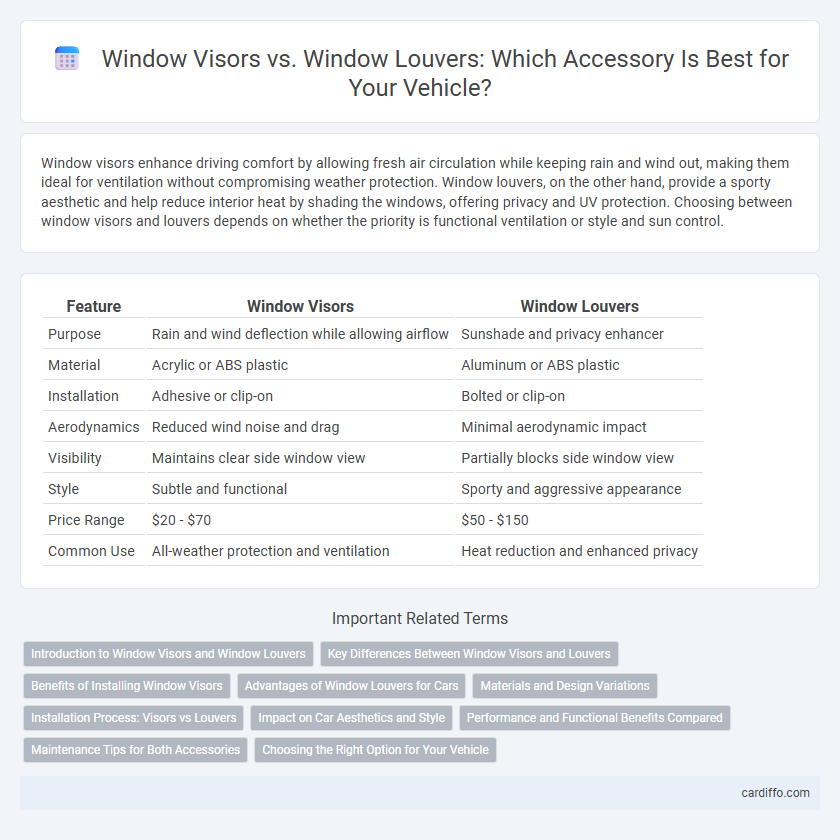Window visors enhance driving comfort by allowing fresh air circulation while keeping rain and wind out, making them ideal for ventilation without compromising weather protection. Window louvers, on the other hand, provide a sporty aesthetic and help reduce interior heat by shading the windows, offering privacy and UV protection. Choosing between window visors and louvers depends on whether the priority is functional ventilation or style and sun control.
Table of Comparison
| Feature | Window Visors | Window Louvers |
|---|---|---|
| Purpose | Rain and wind deflection while allowing airflow | Sunshade and privacy enhancer |
| Material | Acrylic or ABS plastic | Aluminum or ABS plastic |
| Installation | Adhesive or clip-on | Bolted or clip-on |
| Aerodynamics | Reduced wind noise and drag | Minimal aerodynamic impact |
| Visibility | Maintains clear side window view | Partially blocks side window view |
| Style | Subtle and functional | Sporty and aggressive appearance |
| Price Range | $20 - $70 | $50 - $150 |
| Common Use | All-weather protection and ventilation | Heat reduction and enhanced privacy |
Introduction to Window Visors and Window Louvers
Window visors are aerodynamic accessories installed above vehicle windows to reduce wind noise and allow fresh air circulation during rain. Window louvers consist of slatted panels that provide shade and enhance privacy while improving the car's sporty appearance. Both accessories contribute to comfort and style but serve different functional and aesthetic purposes.
Key Differences Between Window Visors and Louvers
Window visors are designed to allow fresh air circulation while protecting the vehicle interior from rain and wind, typically made from acrylic or polycarbonate materials. In contrast, window louvers offer a more aggressive, aerodynamic look by partially covering the rear side windows, often crafted from ABS plastic or aluminum for enhanced durability and sun protection. Key differences include their functional focus--visors prioritize weather protection and ventilation, whereas louvers emphasize style, privacy, and UV shielding.
Benefits of Installing Window Visors
Window visors enhance vehicle comfort by reducing wind noise and minimizing rain intrusion when windows are slightly open, improving ventilation without compromising interior dryness. They contribute to driver safety by allowing fresh air circulation while preventing foggy windows, ensuring clear visibility. Additionally, window visors complement vehicle aesthetics with a sleek, aerodynamic design that does not obstruct views or vehicle lines.
Advantages of Window Louvers for Cars
Window louvers provide superior sun protection by blocking direct sunlight while maintaining airflow, reducing cabin heat more effectively than window visors. They enhance privacy and add a sleek, aggressive aesthetic that complements the vehicle's design. Their durable construction also offers better resistance to weather elements and reduces glare without obstructing the driver's view.
Materials and Design Variations
Window visors are primarily crafted from high-quality acrylic or polycarbonate materials, offering durability and a sleek, aerodynamic design that enhances vehicle style while reducing wind noise. Window louvers often utilize ABS plastic or aluminum, featuring a distinctive slatted design that provides shade and privacy while adding a sporty, aggressive aesthetic to the car. The choice between acrylic visors and ABS or aluminum louvers depends on desired functionality, with visors focusing on ventilation and rain protection and louvers emphasizing sun control and visual impact.
Installation Process: Visors vs Louvers
Window visors typically feature a straightforward installation process requiring adhesive tape or clips, making them faster and easier to attach without drilling. Window louvers demand a more complex installation involving screws or bolts, which usually requires precise alignment and potential modification of the vehicle's window frame. The simplicity of visor installation often appeals to DIY enthusiasts, while louvers may need professional installation for a secure fit and optimal durability.
Impact on Car Aesthetics and Style
Window visors subtly enhance car aesthetics by adding sleekness and functionality, allowing fresh air circulation without compromising style. Window louvers offer a more aggressive, sporty look, emphasizing muscular lines and a retro vibe that appeals to performance car enthusiasts. Both accessories influence the vehicle's visual appeal, with visors promoting elegance and louvers delivering a bold, dynamic statement.
Performance and Functional Benefits Compared
Window visors enhance cabin ventilation by allowing windows to be cracked open during rain without letting water in, reducing wind noise and glare for a more comfortable driving experience. Window louvers improve vehicle aerodynamics and provide shade, lowering interior temperatures and protecting against UV damage while maintaining privacy. Both accessories optimize airflow and comfort, but visors emphasize weather protection and noise reduction, whereas louvers focus on heat management and style.
Maintenance Tips for Both Accessories
Window visors require regular cleaning with mild soap and water to prevent dirt buildup and maintain visibility, while avoiding abrasive materials that can scratch the surface. Window louvers benefit from periodic dusting and inspection for cracks or loose components, ensuring proper airflow and durability. Both accessories should be checked for secure installation to prevent rattling or water leaks during rain.
Choosing the Right Option for Your Vehicle
Window visors enhance ventilation by allowing fresh air circulation while protecting against rain and wind, making them ideal for drivers who prioritize comfort and all-weather usability. Window louvers provide a sleek, aggressive look and help reduce sunlight and heat inside the vehicle, appealing to those focused on style and interior temperature control. Selecting between window visors and louvers depends on whether functionality for ventilation or aesthetic and sun protection is the primary goal for your vehicle customization.
Window visors vs Window louvers Infographic

 cardiffo.com
cardiffo.com